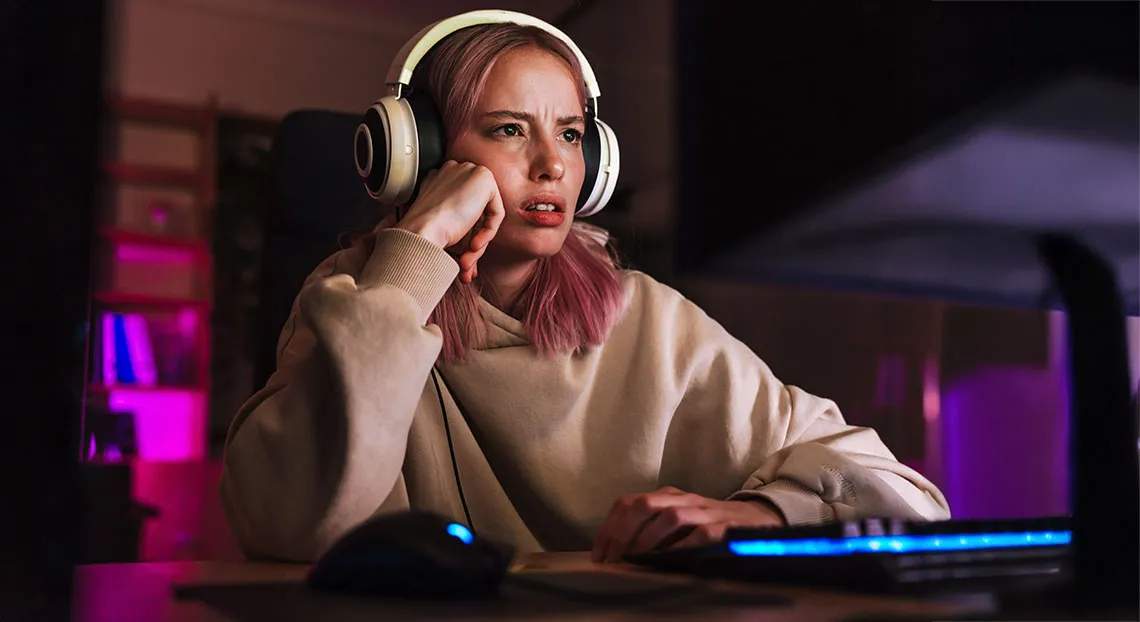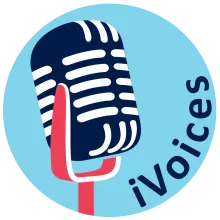A Student’s Story Led to Award-Winning Information Science Research on Women Gamers’ Responses to Misogyny

Photo by Drobot Dean, courtesy Adobe Stock.
Misogyny is an everyday adversary for women gamers. Information science, led by student storytelling and research, shows how they build a community to overcome it.
In the fall of 2021, I was teaching a large course on social media and also running the University of Arizona iVoices Media Lab. Because of COVID, all my teaching, classes and office hours were online, except for the occasional recording session with our iVoices podcast team. One day, a young woman in my course asked me if she could do additional work for an extra certification. As busy as I was, I always made time for stories, so I told the student, Kiersten, that if she had a story to share, I would work with her to make it into something for our iVoices podcast, and include it on our open textbook, Humans R Social Media.

Diana Daly, Associate Professor of Practice and Associate Dean, Undergraduate Academic Affairs and Student Success.
When she approached me, Kiersten hadn’t known much about iVoices, a student-led media lab that produces stories by students. Like many students, she had an experience on social media that felt meaningful, and she wanted to share it to better to understand it. When Kiersten first told me her story idea, it was almost a question: She’d made a friend online, but the friendship went bad, and it was in the middle of the pandemic when everything seemed to go bad, so... why? I told her to write her story down for us to discuss. From then on, Kiersten revised the story every week, and we would talk through it while she made notes for the next iteration.
By mid-semester, the story of Kiersten’s relationship with this new friend was taking shape through her writing, with my questions helping guide her. New details emerged. She’d been a “social butterfly” before the pandemic. The new friend was someone she was initially excited to hang out with while playing the video game Rainbow Six Siege. Then he started to “get weird” with her. It became clear that he was sexually harassing her, and some of my questioning at that point felt difficult, even to me. But it wasn’t just me who would be listening to Kiersten’s story. I was a proxy for an audience who would fill in the gaps with their own narratives. I persisted.
“Did you like him?” I asked.
“I had a boyfriend,” she said.
“That doesn’t answer my question. I want to hear how you felt about him, boyfriend or no boyfriend.”
“He was creepy.”
“Okay. What made him creepy? Can you give an example?”
Other questions I asked were in a more familiar vein for me, a middle-aged professor learning from students immersed in social media. “What’s a chud?” I asked. “Well...,” she said, laughing and rolling her eyes.
Guided Storytelling
In the last month of the semester, the story of their relationship was there, but I still had questions. What in the world around Kiersten had drawn her into this friendship and made it so difficult to get out of? It was only once she began describing toxic patterns in the game chats—and the warped expectations that they led to even for a vivacious, intelligent person like her—that the missing pieces of narrative fell into place.

Our podcast team—me plus student workers Gabe Stultz and Jacquie Kuru—recorded Kiersten’s story in studio the last week of the semester. I still remember how confident Kiersten had become, creating a story about her history in her voice, and telling it beautifully in one take through a white mask. I think she was happy to be around people, and you can hear it in her delivery. Gabe recorded her narration, and Jacquie and I coached her occasionally. Mostly, though, we just listened and appreciated what a great storyteller Kiersten had become. Her story, Social Media and Ourselves podcast episode “Girl Meets Chud,” was released in December 2021.
iVoices had a few research questions, but after Kiersten’s story was produced, I kept thinking of one in particular: In what ways do students’ narratives around technologies enrich new media scholarship? I had just had the honor of witnessing a young woman form and share a powerful response to the misogyny she faced in gaming discourse. How, I wondered, did other young women respond to being told to “go back to the kitchen?”
From a Student Story to Student-Faculty Research
Over the next few months, that question drove inquiry with a new research team I was leading, including Master of Science in Information Science student Duo Bao and Bachelor’s in Information Science and eSociety student Maddie Rae Smith. We mined TikTok for videos posted between July 25, 2021 and July 24, 2022 with the hashtags #backtothekitchen and #gobacktothekitchen. Our goal was to explore how misogyny was portrayed in these videos and to identify the most prominent types of content.
Our research followed a qualitative research practice called naturalistic inquiry, meaning we observed the posts in the context where they were created and shared—which meant we spent a lot of time on TikTok. We found 83 videos with at least one of those two hashtags, 78% of which contained misogynistic content, forming our initial dataset. Any videos that did not contain misogynistic content—say, recipe videos about cooking in actual kitchens—were left out of further analysis.
We coded each of three important qualities of memes from theoretical work on memes by Limor Shifman, author of Memes in Digital Culture. These TikTok videos were memes in the sense that those who created and interacted with them were responding to a trend in their chosen ways, and changing the trend as they spread it. Shifman broke memes down to have three attributes: content, form and stance.
Video Response Content, Form and Stance
We found in our coding of the content that these videos fell mostly in two categories:
- Videos where creators were asking for comeback suggestions from their audience
- Videos where creators demonstrated specific comebacks against misogynistic comments
Next, we examined the form or style of the videos and categorized them into several formats. These included:
- Gameplay demos, where creators showed actual gameplay footage featuring their responses to misogyny
- Lip-synching, where creators synced their lips to audio clips containing comebacks from films or other media
- Talking head videos, where the creators spoke directly to the camera, showcasing their responses
Some videos used enhanced onscreen messaging, with text overlays or visual elements like sim avatars to convey their message.
We also analyzed the stance or tone of the videos to understand the attitude of the creators. Some videos were coded as sincere or bothered, where the creators appeared genuinely upset or earnest in their responses. Humor was a prevalent stance, with creators using wit and satire to address and undermine misogynistic comments. In some videos, creators were angry or frustrated. Others exhibited a triumphant or not bothered stance, where the creators appeared unaffected or victorious over the misogyny.
As we learned more about our corpus, we began developing theory around these memes based on the data, a practice called grounded theory.
Those facing misogyny online used the affordances of TikTok to quickly create content and respond in networked publics around the hashtags we studied. Creating and gathering around this content helped them vent, gather resources to weather anticipated future misogyny, and build community around their continued struggles to participate safely and equally online.
What We Found: Humor, Power and Community
One trend we focused on was “comeback appeals,” where young women gamers suggested responses to misogynistic comments like “Go back to the kitchen.” The comeback appeals content we analyzed had over five million views, around one million likes and over 17,000 comments. We examined examples of this trend, categorizing the videos by content (asking for or demonstrating comebacks), form (e.g., gameplay demo, lip-synching) and stance (e.g., humorous, angry, triumphant). We also noted counterattacks from apparent male users, which were less common and reinforced stereotypes.
Patterns we found in the comeback appeal videos included humor as the most prominent video stance, offering or drumming up witty responses to counterstrike male-identified attackers. One common theme in these conversations was performing positions of power to gain leverage over an aggressor, through sexuality, therapy positioning by diagnosing aggressors as having “daddy issues,” homophobia or age difference. In one example of the age difference power positioning, a young woman called on the community with the tagline, “Where my girl gamers at 🔥” and lip-synced to a song by Dessyy that has been reused hundreds of times.
Yeah I’m a girl, why does it matter to you?
I’ve been playing this game for years. Trust me, I’m not new.
Hmm what was that? You want me to be quiet?
So I’m hitting my head shots. Maybe you should try it.
Teammates, this girl is being mean!
Oh my god, I forgot I’m babysitting a teen!
What was that? Go back to the kitchen?
Oh I will, once you play and quit your bitchin’.
We also found themes in counterattacks from what appeared to be male-identified users, including reinforcement of misogynistic stereotypes such as that women are not funny, or “tech bro mansplaining” that creators are using wrong equipment or gaming wrong or badly.

Videos in our corpus were typically created by young women gamers toward whom “back to the kitchen” had been directed. They added hashtags to their posts as appeals for visibility in general and on gaming platforms in particular; as identity pronouncements to signify belonging; to call out systematic oppression and defy it; and to occasionally echo misogyny.
We also coded the two most liked comments per video and the most liked reply to each of these comments. The codes used included offering a comeback the creator could have used, for comments that suggested or supported comeback responses; insults or countercomebacks, for comments that continued the misogyny or criticized the creator’s response; and supportive comments showing agreement with the creator’s stance.
Overall, we found that those facing misogyny online used the affordances of TikTok to quickly create content and respond in networked publics around the hashtags we studied. Creating and gathering around this content helped them vent, gather resources to weather anticipated future misogyny, and build community around their continued struggles to participate safely and equally online.
A Top Paper in Information Science
We published our research, “The Incessancy of #gobacktothekitchen and Responses to Normalized Online Misogyny.” in the Proceedings of the Association for Information Science and Technology (ASIST) in 2022, and in 2023 I learned I had become one of their most read authors. This was bittersweet news: I am thrilled that people are reading and using this work, and dismayed that misogyny in online gaming platforms persists.
I thought about trying to contact Kiersten to tell her the news about the article, but she had moved on from my course by then, after writing me a beautiful thank-you card I still keep on my desk. I will always remember how she regained confidence from carefully crafting her story and sharing it. I hope those TikTok posts did the same for their creators.
The podcast episode “Girl Meets Chud” is available in the 2024 open educational resource textbook Humans R Social Media, in the closing of the chapter titled “Equity.”
Dr. Daly's media production and research with students was funded by the U of A's Center for University Education and Scholarship and Vertically Integrated Projects.
Learn more about Diana Daly on her faculty page or explore other stories of transformative research by faculty of the College of Information Science.

